Aerial Derby - 1921
-
-Aerial Derby 1921
THE SIXTH
AERIAL DERBY
FOR
THE ROYAL AERO CLUB TROPHY and £400 for the FASTEST TIME;
TROPHY and £200 for 1st in the Handicap;
£100 for 2nd in the Handicap, and
£50 for 3rd in the Handicap

Saturday 16th July 1921. Start and Finish: Hendon
Turning Points: Brooklands, Epsom, West Thurrock, Epping, Hertford (same as in 1920)
Weather: "Almost overpoweringly hot"
2 laps of 100 miles miles. Start: 3pm
Story of the Race:
"Disappointing... it presented a sort of tameness. No doubt this was due to the fact that out of twenty machines, eight scratched, the majority of which were favourites or 'dark horses'"
Mr D. L. Forestier-Walker has a narrow escape 
Pilot Aircraft (click here for more details) Race No Result
Speed/Handicap
Capt T Tully Avro 534 Baby G-EAUM 1 retired - forced landing at Brooklands on Lap 2 
Mr H L J 'Bert' Hinkler Avro 534C G-EAXL 2 retired on Lap 1 
Dring Lester Forestier-Walker Sopwith Pup G-EAVX 4 retired on Lap 1 - felt ill, then nosed over on landing at Hendon when undercarriage collapsed 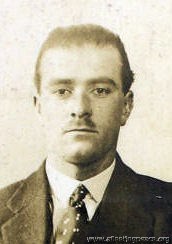
Mr Alan S Butler Bristol 29 G-EAWB 5 4th/3rd 
Maj Leslie R Tait-Cox Avro 552 G-EAPR 6 5th/5th 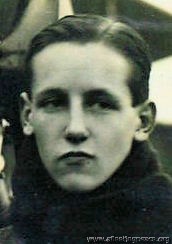
Capt Hubert S Broad Sopwith Camel G-EAWN 7 6th/6th 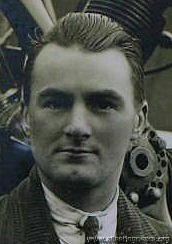
Capt Walter H Longton SE.5a G-EAX_ 28 3rd/2nd 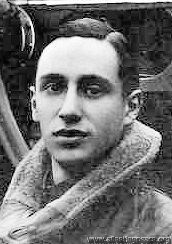
Mr Frederick J Ortweiler SE.5a G-EAXU 30 Disqualified - incorrect pylon turn at end of Lap 1 
Flt-Lt Jack Noakes Nieuport Nieuhawk LC.2 G-EAJY 12 Retired on Lap 2 - out of fuel 
Maj Ernest L Foot Martinsyde F.4 G-EAXB 15 Retired on Lap 1 - oil-feed problem 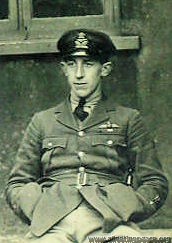
Capt Cyril F Uwins Bristol Type 32B Bullet G-EATS 17 2nd/4th 
Mr Jimmy James Gloster Mars I G-EAXZ 21 1st/1st Starters: 12 (of 20 entrants) Finishers: 6
Did not start:
Pilot Aircraft Race No Capt Alan Harper Curtis BE.2e 3 Sqn-Ldr Christopher Draper B.A.T. Bantam 11 Major S H Long Martinsyde F.4A Mr Harry G Hawker Nieuport Goshawk 14 Mr Frank T Courtney 'Alula' monoplane 16 not ready Mr Bernard de Romanet de Monge V.A. 18 Capt D G Westgarth-Heslam Avro 19 was hurt on Thursday Sadi Lecointe Nieuport 20 -
-The Aviators
The Aviators
-
Broad, Hubert Stanford
Capt Hubert Stanford Broad MBE AFC
 photo: 1930, aged 33
photo: 1930, aged 33b. 18 (or 20) May 1897
shot through the neck in WWI by one of Richtofen's Red Circus pilots; [c.f. Angus Irwin]; second in Schneider 1925, to Jimmy Doolittle.
In 1928, he spent possibly the most boring 24 hours of his life by beating 'all existing figures' for long endurance flights in light aeroplanes (unfortunately there was no official 'record' to beat as such, the FAI not recognising such things). His log makes, um, rivetting reading:
--0--0--0--0--0--0--0--0--0--0--
5:30pm: Hendon
7:40pm: Gloucester
8:30pm: Coffee and sandwiches
11pm: Over Central London, 3,000ft; watched theatre crowds leaving
Midnight to dawn: Remained over Edgeware
2:30am: second meal
4:10am: First signs of dawn
5:10am: Biggin Hill. Saw night bomber in air
...
Noon: Stamford. Very sleepy
4:30pm: Ipswich
--0--0--0--0--0--0--0--0--0--0--
Having trimmed the controls, Hubert settled down and read 3 complete novels 'to relieve the boredom'.
When he finally landed, he he said that he was very stiff with cramp, and promptly went home to sleep. His Moth still had 12 gallons of fuel, so it could have kept going for another 4 1/2 hours...
He was named as co-respondent in Beryl Markham's divorce in 1939.
de Havillands test pilot until 1935 (Bob Waight succeeded him) - broke the world's speed and height records for light aircraft in the original monoplane Tiger Moth, then joined RAE Farnborough; Hawker test pilot post-WWII; died 1975
FLIGHT MARCH 28TH, 1946
No. 2. CAPT. H. S. BROAD, Senior Production Test Pilot, Hawker Aircraft Co.
FOR sheer wealth of flying experience it is doubtful whether there is another pilot in the world to equal Hubert Broad. He has flown everything from diminutive single-seaters to multi-engined--bombers, and including a number of out-and-out racing aircraft. His logbooks, of which he has filled some nine or ten, total over7,500 hours' flying time and 182 separate types. These are honest types—not modifications or different mark numbers of the same aircraft. Many of these he has also flown as seaplanes. Broad, at the age of nineteen, learnt to fly at the Hall School of Flying at Hendon in 1915. The aircraft on which he made his first flight (there was no dual, a pupil did straights across the airfield until he felt it was safe to do a circuit)was the single-seater Caudron with35 h.p. Y-type Anzani engine. Believe it or not, with this tiny horsepower the Caudron occasionally was made to stagger into the air with two people on board, but the passenger had to sit on the wing by the side of the nacelle.
Early Days
The end of 1915 found Broad in the R.N.A.S. at Eastchurch, and he was on the very first course at Cranwell, which was then a R.N.A.S. establishment rejoicing in the name of H.M.S. Daedalus. His first tour of duty at the front was with No. 3 Squadron at Dunkirk. He was among a number of pilots lent by the R.N.A.S. to the R.F.C. No. 3 Squadron flew Sopwith Pups, and it was while he was on one of these, escorting a bombing raid by 90 h.p. R.A.F.-engined B.E.s, that he was shot through the neck by one of Richtofen's later Goering's—Red Circus pilots.
On recovery he spent a while as an instructor at Chingford and then went for his second tour of operations with No. 46 Squadron, who flew Sopwith Camels. The end of the 1914-18 war found Broad instructing at the Fighter Pilots' Flying School at Fairlop.
Peace found him, as it found so many other young fellows ,with the ability to fly aircraft superbly and no other means of making a living. But a good living could be made by joy-riding in the early 1920's. First he joined the Avro Company, who were running joy-riding in a fairly big way, and in 1920 went to the Adiron Lakes in America with two Avro 504 seaplanes. These two aircraft saw their last days in Long Island, where they were completely wrecked by an autumn gale.
By the next year he was back in England competing in the Aerial Derby air race round London on a Sopwith Camel. He finished 6th.In October, 1921, Broad joined de Havillands. Those who know this great concern now will smile to learn that when it started in those days it consisted entirely of two fabric hangars and a hut at Stag Lane. If memory serves, the capital of the company at that time was £100.
The D.H. series numbers, which started in the Aircraft Manufacturing Co. Ltd., were carried on in this new firm, and Broad flew every one of the D.H. designs from the D.H.27 to the D.H.90. In the same period he did a lot of test flyingfor other aircraft constructors.
He did the W.10, Handcross, Hendon, and some others for Handley Pages, the Parnall Pipit and the Saunders A. 10 fighter. On the Gloster Grebe he ran into wing flutter for the first time (this trouble, in those days, was on a par with the compressibility troubles we have now).
Seaplane testing
Another big job he did was most of the development work on the Gloster II and III racing seaplanes. Over a period I used to go with him to Felixstowe regularly. As a Press man I was forbidden the precincts of the R.A.F. seaplane station, but there was a perfectly good Great Eastern Railway pier alongside the station. I used to climb over the fence and watch the proceedings from the pier head. Broad nearly lost his life there one day in October,1924. As he was landing the Gloster II a forward strut to the floats collapsed, and the aircraft turned completely over. Mrs. Broad was watching from the shore, and it seemed a very long time before Hubert appeared on the surface.
In 1925 Hubert Broad flew the Gloster III racing seaplane in the Schneider Trophy contest which was held that year over Chesapeake Bay in America. This was the race in which Henri Biard, flying the SupermarineS.4—the true forerunner of the Spitfire—crashed in the water with wing flutter. Broad finished this race second to Jimmy (now General) Doolittle. That must have been a vintage generation, because many names from that period have found their way into the high-spots of this last war.
With the advent of the D.H. Moth in all its variants, Broad was to be seen performing aerobatics at most flying club meetings and entering many of the races. These included the King's Cup Race, which he won in 1926. He was flying a delightful Cirrus I Moth, which was a study in ivory and red. His average speed over the whole732 miles was 90.4 m.p.h. His piece de resistance in aerobatics was a perfectly formed big loop, the base of which was only some 150ft from the ground. It was a joy to behold, but very dangerous to perform. Broad had sufficient sense to realise this and sufficient courage to stop doing it.
"Hooked"
It was during an aerobatic show that Hubert had his closest shave in a life packed with incident. And it was so simple. Flying a D.H. Tiger Moth with no one in the front seat, he did a slow roll—a stunt at which he was a master. The safety belt in the empty cockpit was loosely done up. While the Moth was inverted the belt hung down and, as the aircraft turned the right way up again, the belt came back over the joy-stick. The result was that Broad had only about 1 1/2 inches of stick movement; but, nothing daunted, he made a sort of tail-up, seaplane landing. In this connection it is to be remembered that there were no lovely 2,000-yard runways on which to this sort of thing. In those days there was not a single runway available in Britain; not even for the take-off of over-loaded aircraft for long-distance records!
Another unhappy moment occurred when he found the tail trim (the incidence of the whole tailplane was adjustable)of a D.H.34 had been connected in reverse. By a good deal of jockeying he managed to get into Northolt. On yet another occasion a careless mechanic left a screwdriver jammed in the chain and sprocket of the rudder actuating gear. This necessitated a down-wind, crosswind, finishing up into-wind landing at Hendon airfield, because that was a bit bigger than Stag Lane.
One of the prettiest little aircraft he ever flew was the original D.H. Tiger Moth monoplane. This was tailored exactly to fit Broad. Physically he is not of big stature and few other pilots could get into the machine. In the front of the cockpit was a bulkhead which had two holes just large, enough for the feet to be threaded through, and these holes had to be padded with sorbo rubber so that Broad's shins did not get barked while landing and taxying. Springing was almost non-existent. Span was22ft 6in and length only 18ft 7m.
In August, 1927, on this machine he broke the world's record for light aircraft for both speed and height. For the former the figure was 186.47 m.p.h., he having taken19 min 59 sec to cover the 10 km, and for altitude he reached 20,000ft in just 17 min. A year later he took two more world's records on the D.H. Hound.
In 1935, after 20 wonderful years of service, he left de Havillands and later did some flying for the Air Registration Board. From here he went to the Royal Aircraft Establishment and finally joined Hawkers to be in charge of all their production testing at Langley. He will be 50 in a matter of a few weeks, yet every day sees him at oxygen height testing Tempest IIs. As he says, he has gone from 35 h.p. in the Anzani to over 3,000 h.p. in the Centaurus and Sabre VI, and from 2 ½ lb/sq ft in the Caudron to 40 lb/sq ft in the Tempest II.
-
Butler, Alan Samuel
Mr Alan Samuel Butler J.P. 
photo: 1921, aged 23
Chairman of de Havilland; the story goes that in 1921 he asked the one-year old de Havilland Aircraft Company to build a fast two-passenger touring aeroplane to his specification,
and stumped up £3,000 for them to do it. The money saved the company from extinction and they appointed him to the board of directors forthwith. He held the position until he retired in 1950.
The aeroplane became the DH37, (which he named, firstly, 'Sylvia' after his sister, then, rather diplomatically, 'Lois', after his wife, q.v.), which he entered in the very first King's Cup Race in 1922 and again in 1924, coming third.
He and Lois set up a world speed record of 120mph for 1000 km in 1928, and they also flew to Cape Town together .
Entered the MacRobertson Race in 1934 (assigned No 59) but didn't take part.
Was still aviating in 1970.
-
Foot, Ernest Leslie
Lt Ernest Leslie Foot MC 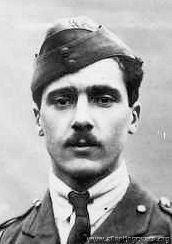
photo: 1915, aged 20
b. 19 May 1895 in Pulborough, Sussex
WWI ace (5 victories), awarded the Military Cross for 'conspicuous skill and gallantry'.
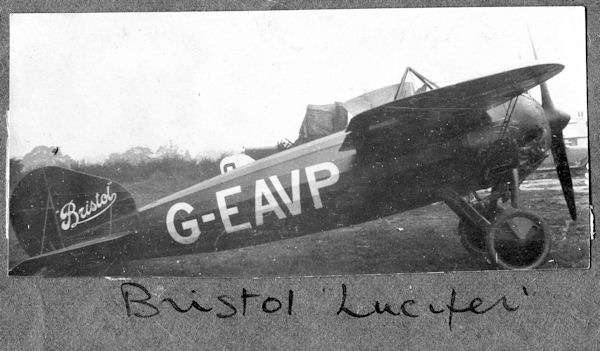
d. 23 June 1923 when the Bristol M.1D G-EAVP (which flew in both the Aerial Derby and the King's Cup in 1922) lost a wing and crashed near Chertsey.
-
Forestier-Walker, Dring Lester
Mr Dring Lester Forestier-Walker 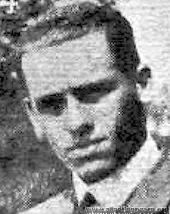
b. c.1900
1921 was his only Aerial Derby, and he crashed the Sopwith Pup (which he presumably borrowed from its owner Mr Rickards) at Hendon. There is a rumour that he may have been drunk.
The aircraft survived, however (or at least its fuselage did) and is under long-term restoration at RNAS Yeovilton.
d. Dec 1968 in Aylesbury.
-
Hinkler, Herbert John Louis
Sqn Ldr Herbert John Louis Hinkler 
photo: 1927, aged 35
Australian 'Lone Eagle', aviation pioneer, killed in a crash in Italy in 1933
-
James, John Herbert
Lieut John Herbert 'Jimmie' James 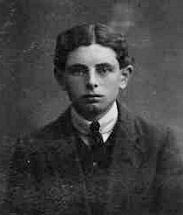 1912, aged 18
1912, aged 18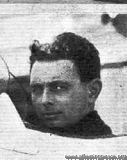 1920
1920b. 2 June 1894 in Narberth, Pembrokeshire (which is in Wales); in 1913, he and his brother Henry were the first people in Pembrokeshire to build and fly their own aeroplane.
It was a sort-of-Caudron biplane and during its first flight it fell 60 feet to the ground, luckily without serious injury, and had to be rebuilt. It worked all right after that, though.
After WWI, he became test pilot to the British Nieuport Company; in April 1920 he flew the Nieuport in Bombay on a publicity trip, and its handling was "much admired". Nieuport later became Gloster Aircraft, and among his many accomplishments was the British Speed Record of 196.6 mph in a Gloster Bamel in 1921.
d. 4 Feb 1944, although he had "given up flying some time before".
-
Longton, Walter Hunt
Flt-Lt (later Sqn-Ldr) Walter Hunt Longton  1916, aged 24
1916, aged 24'Scruffie' Longton, from Lancashire. 11 victories in WWI flying SE5s; DFC and bar.
Well known pre-war motor-cycling, and post-war aeroplane racer; whilst practising for the Bournemouth Air Meeting in April 1927, his aeroplane was hit by "one or two charges of shot from a sporting gun", possibly in protest at flying races on a Good Friday. A reward of £25 was offered for the detection of the culprit.
He was killed soon after - June 1927 - in a mid-air collision at the Bournemouth Whitsun Meeting, flying the prototype Bluebird.
"Every aircraft constructor knew that 'Longton's opinion' was worth having on anything new." C G Grey
-
Noakes, Jack
Sqn-Ldr J 'Jack' Noakes 
photo: 1921, aged 27
presumably Jack Noakes, b. 9 Apr 1894 in Brighton
RAeC Certificate 1092 (1915); later an Air Commodore
-
Ortweiler, Frederick John
Mr Frederick John Ortweiler MC  1917, aged 19, when a 2nd Lieut on the General List
1917, aged 19, when a 2nd Lieut on the General List'Freddy', b. 25 Feb 1898 in London
His father Simon came to England from Germany in the 1880s and, "conceiving an affection for British institutions", became a Britsh citizen in 1897. He then founded a company making ladies' handbags. The firm was subject to anti-German propaganda by their English trade rivals in 1915, but Simon sued them, successfully, and was awarded £250 damages.
Freddy and his brother Bobby then went to Officer Training Corps near London, and Freddy joined 29 Sqn RAF. Flying behind the German lines on 16 October 1917, he was attacked by 5 planes, shot down and taken prisoner. His account of his time as a prisoner-of-war is in the National Archives, and his diaries, some letters and photos are in the RAF Museum.
Of the Ingelmunster collecting station, he says "we were locked in our rooms most of the time, and we received the same food as the German soldiers, but it was poor to us"..."I have reasons to believe that there were microphones in use. The officers were taken out one by one to be interrogated... we naturally talked of what we didn't tell, and could be overheard."
On the train to Germany, "I can speak German, and insisted to the German officer commanding at the station that I was an officer and should at least go 2nd class"..."we had a little coffee, but no food. No heating in the train - very cold".
At Burg, "we got no parcels, and the consequence was that we got very weak and ill, as we could not do on the German food"...."we were always shouted at, instead of being spoken to in a civil way".
Transferred to Halle Camp with all the other British prisoners, he escaped in January 1918 but was caught on the Dutch border. "I had no trial, and was kept in solitary confinement for a month".
Later the camp commandant "shouted at me for about five minutes, and told me I was a German, and asked me whether I had been born in Germany. I said 'No, thank God', and he gave me three days' cells without reading, writing or smoking, and in his temper tore the bedclothes off the bed. A very violent man."
"Our great weapon was to laugh. The Germans cannot stand ridicule."
The original documents can be seen here and here
He escaped from Stralsund Camp, Germany, on 12th October 1918 and arrived back in England on 31 October (so, 12 days before the Armistice).
He was killed 14 Feb 1922 in a flying accident at Cuatro Ventos Air Base in Madrid, in a Bristol aeroplane which had been acquired by Spain. He was buried at the Willesden (Jewish) Cemetery in London.
Bobby died 18 Jun 1927 aged 27; Simon on 10 July 1938.
Their mother, their surviving brother Ernest and sister Martine put 'In Memoriam' notices for both Freddy and Bobby in the newspapers, right up until 1946. They were obviously both sadly missed.
-
Tait-Cox, Leslie Robert
Maj Leslie Robert Tait-Cox  1916, aged 19
1916, aged 19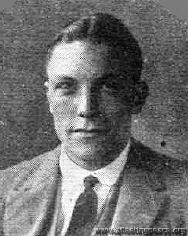 1920
1920b. 27 April 1897 in London
RFC and RAF in WWI, then an "exceptional" test pilot for Nieuport and General Aircraft Co Ltd, of Cricklewood.
Elected a Member of the RAeC in October 1921; at the time, the firm of 'Tait-Cox and James, Test Pilots' were extremely busy, and "could find work for half-a-dozen pilots", if they could find them.
In fact Leslie, followed by Jimmie, broke the British Speed record in 1921.
Joined Major Jack Savage's 'Sky-writers' in 1922 - as did Mogens L Bramson, Cyril Turner, G A Lingham, G F Bradley, D A Shepperson, C R McMullin, E D C Herne, Sydney St Barbe, Charles Collyer (US), Marttin Rudolph (Germany), and W von Feilitzsch (Germany).
Rejoined the RAF in 1926, and left in Jan 1935, to become a "Technical Mechanical Engineering Liason Officer"
Joined Plessey after WWII and d. Oct 1959 - Maidenhead, Berks.
-
Tully, Terence Bernard
Capt Terence Bernard 'Terry' Tully AFC 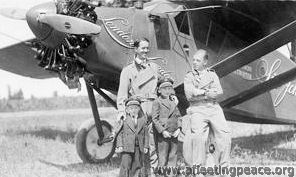
(on left)
Image courtesy images.ourontario.ca.

one of Canada's rarest air mail stamps - only about 9 are known to exist, and they go for about $35,000 each
b. 18 Dec 1891 in Carracastle, Mayo, Ireland.
RFC from September 1914, then RAF; served in Egypt, and in the Dardanelles in 1916 (just after the Gallipoli campaign had ended in failure). Air Force Cross in June 1918. He left the RAF in June 1922, joined the Reserve of Air Force Officers as a Flying Officer in April 1923, then became a naturalised Canadian and joined the Ontario Provincial Air Service as a pilot.
d. c.7 September 1927, trying to cross the Atlantic from London, Canada, to London, England.
Carling Breweries of Ontario had offered a $25,000 prize to any Canadian or British subject making the flight; eventually, they also agreed to provide the plane, M-202, a Stinson SM-1 Detroiter monoplane named 'Sir John Carling'. Terry, and his navigator [and fellow Irish-Canadian] Lieutenant James Victor Medcalf, gave up their jobs to make the attempt, and were sworn in as 'official carriers of government mail' by the mayor of (Canada's) London.
Their first flight was made on 29 August, 1927. 10,000 people watched the aircraft take off; it got as far as Kingston, Ontario but had to return to base because of fog. It took off again at 5am on the 1st September, but fog and heavy rain again forced it to land in Caribou, Maine and stay there until 5 September when they flew to Harbour Grace, St. John's Newfoundland.
They set off across the Atlantic at 09:45 on 7 September, and were spotted 30 miles out, flying past Cape St Francis. They were never seen again, however, and an extensive search failed to find any trace. [One bag of air-mail had been left behind, hence there are still a few stamps around].
They had taken out insurance (which paid out $15,000), so that and the $25,000 prize were put in trust for their wives and 3 children.
-
Uwins, Cyril Frank
Mr Cyril Frank 'Papa' Uwins OBE 
1916, when a 2nd Lieutenant, London Regiment, aged 20
.jpg)
in 1954, elected vice-President of the Society of British Aircraft Manufacturers
The "rather withdrawn", chief test pilot for Bristol Aircraft, and their Assistant Managing Director after 1947; President of SBAC in 1956; died 1972
was, in fact, "very good at high-flying" and broke the world's height record by climbing to 43,976ft in 1932


